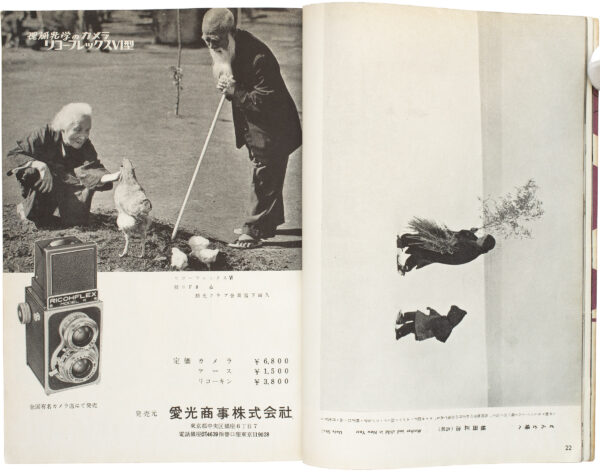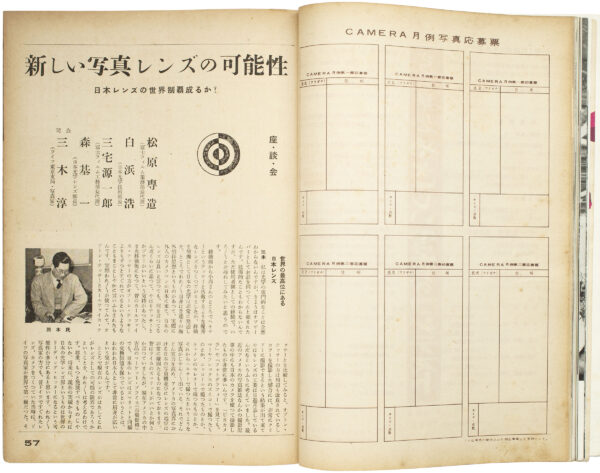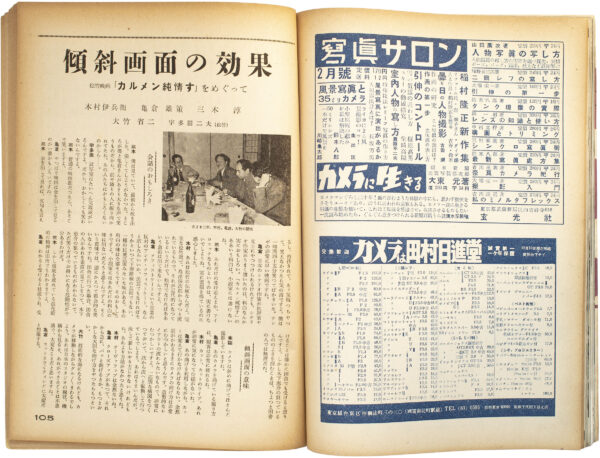Camera カメラ
April 1921 - August 1956
Monthly
Founding Publisher: Ars (Tokyo)
Founding Editor: Takakuwa Katsuo
B5 size, approx. 18 x 26 cm.
Although many issues are marked ‘ars camera’ in roman letters, the Japanese title is simply Kamera.
Ars, in roman letteres or アルス (Arasu) in katakana, was the publisher.
Camera was launched to promote amateur ‘hobby photography’. It established the basic format of modern photography magazines: a section of photographs at the front, photography contests and technical articles.
Under the wartime reorganization of print media, it was consolidated with several other magazines in Januari 1941 and published as Shashin Bunka ( Photographic Culture). The name was later changed to Shashin Kagaku ( Photographic Science ).
Publication halted briefly with the May-June issue of 1945 but was resumed under the name Camera in Januari 1946. (Shirayama Mari; Major Photography Magazines. The History of Japanese Photography 2003)
Kuwabara Kineo became editor in September 1948 and the magazine became a vehicle for the realist photography movement of Domon Ken, who in October 1949 announcent that he and his fellow photographer Kimura Ihei would serve as a judges for amateur contests, beginning in January 1950.
With a circulation between 15,000 and 35,000, Camera had an avid readership of dedicated camera buffs who eagerly participated in monthly photography contests.
Every month, 1000 to 1500 entries ranging widely in style and subject matter overran Camera’s offices.
Domon also had a monthly column which generated much attention. It was in this context that one of the most important movements in postwar photography emerged: social realism. Domon was the torch-bearer for the movement and famously advocated the “direct linkage between camera and subject” and the “absolutely pure snapshot, absolutely unstaged.”
In 1956, with the demise of Camera, Domon Ken moved to Photo Art and served as judge in their monthly amateur photography contests.
.
Camera 1953 - February.
Editor: Kuwabara Kineo.
Cover: Tanemura Takamasa
146 pages, letterpress halftone

Right page; Mother and child in New Year by Ueda Shoji.
Left page; advertisement of the Ricohflex TLR camera. This issue has
42 pages of ads on a total of 146 pages.
Japan’s domestic camera industry showed many Twin Lens Reflex
(TLR) camera manufacturers during these years. In this issue
ads of the Middle Flex, Airesflex, Pigeonflex, Beauty Flex, Laurel Flex,
Welmi-Flex, Olympus Flex, Hobiflex, Alpenflex, Wago Flex,
First Flex, Ricohflex, ElmoFlex, Queenflex, IsocaFlex, Primoflex,
Minoltaflex and the KoniFlex, all TLR camera’s and all in one and the same magazine!
Right page; Mother and child in New Year by Ueda Shoji.
Left page; advertisement of the Ricohflex TLR camera. This issue has
42 pages of ads on a total of 146 pages.
Japan’s domestic camera industry showed many Twin Lens Reflex
(TLR) camera manufacturers during these years. In this issue
ads of the Middle Flex, Airesflex, Pigeonflex, Beauty Flex, Laurel Flex,
Welmi-Flex, Olympus Flex, Hobiflex, Alpenflex, Wago Flex,
First Flex, Ricohflex, ElmoFlex, Queenflex, IsocaFlex, Primoflex,
Minoltaflex and the KoniFlex, all TLR camera’s and all in one and the same magazine!
Monthly contest, selected photo works. Evaluation by Domon Ken.
Right page top; a contribution by Tomatsu Shomei.
A conversation about the movie ‘ Karumen Junjo Su’ , directed and written by Kinoshita. From left to right: Miki Jun, Kimura Ihei, Kamekura Yusako and Ohtake Shoji. 4 Pages.
Amateur Photo Journalist; My Town, My Village. Criticisme by Natori Yonosuke.
Left page; Domon’s monthly review over the photo contest, ‘discover motifs and expressions’. Right page; commentary on this months cover ( top left )
Camera 1953 - April.
Editor: Kuwabara Kineo.
Cover: Akira Ishii.
156 pages, letterpress halftone
Masaaki Hatsuno: Two views of Mount Fuji.
Tadashi ikeda: Mountains in early spring.

Left page; Nakamura Tatsuyuki: Nude study. Right page; Selected works from the International Tokyo Photo Salon, sponsered by Camera.
Left page; Nakamura Tatsuyuki: Nude study. Right page; Selected works from the International Tokyo Photo Salon, sponsered by Camera.
Domon Ken’s monthly essay with critisme about the contributions of the contest. This month: ‘The confrontation between works.’ 3 pages.
‘Monthly Amateur Photo Masterpieces’. Selection and evaluation by Domon Ken Right page: Paintshop by Fukushima Kikujiro.
Left page: Snowfall in Aomori by Kudo Soichi.
Domon Ken about Kudo: (....) “ It can be said that this photograph fully illustrates
Kudo’s growt as an artist”
When Kudo Shoichi ( born 1929 ), see above, right spread, left page, passed away in 2014, his daughter Kanako discovered a large box filed with undeveloped negatives. A small photographic treasure; life in post-war Aomori, the northernmost prefecture of Honshu, Japans main island, captured in hundreds of brilliant impromptu portraits, snapshots and documentary-style images. After his daughter began to publish his photographs on Instagram, Shoichi Kudo posthumously garnered the attention of the contemporary photography community in Japan and all over the world.The photobook “Aomori 1950-1962” presents Kudo’s work in full charm.
.
Kudo Shoichi: Aomori 1950-1962.
19,6 x 14, 8 cm. 432 pages, 366 images.
Hardcover. Text in Japanese and English
Publisher: Misuzu Shobo, 2021
Camera May 1953
Editor: Kuwabara Kineo.
Cover: Inamura Takamasa
150 pages, letterpress halftone
Monthly Amateur Photo Masterpieces selection.
Right page: Flying kites by Maki Matome.
Left page: Snow and wooden horses by Yamada Teruo.
Right page: 3 People at the bus stop by Yamada Teruo.
Left page: 4 Dancers behind the dressingroom by Kimura Hidetoshi.
Right page: Frozen harbor by Kawamura Shunichi.
Left page: Nayoroiwa - Sumo wrestler by Saburo Ota.

Left page ( 73) This months essay ; ‘ Beggar Photography’ by Tanaka Masao, 3 pages. Beggar photography, kojiki shashin ; images of people made homeless by wartime bombing and dislocation, every month a fixed topic in the contributions of the amateurs for the photo contest. In his essay in the April issue, Domon Ken expressed nothing but exasperation about this. He was tired of looking at what he called imitative, uninspired snapshots on the same bleak theme. An outburst directed at the very realismhe himself seemed to represent.In this month ’s article, Tanaka launched a sober and intelligent defense of ‘beggar
photography’ as the only way to grasp reality.
Julia Adeney Thomas’ ‘Power Mader Visible: Photography and Postwar Japan’s Elusive Reality’ , The Journal of Asian Studies Vol. 67, no 2 2008, was very helpful.

Left page; ‘New Photographic Lenses; Will Japanese lenses conquer the world?’ A symposium with Shirahama Hiroshi and Miyake Genichiro ( both from Fuji), Mori Motoi ( general manager Nippon Kogaku optics, nowadays Nikon). Moderated by Miki Jun. 7 pages.
Right page; Camera Monthly Photo application Form.
Left page ( 73) This months essay ; ‘ Beggar Photography’ by Tanaka Masao, 3 pages. Beggar photography, kojiki shashin ; images of people made homeless by wartime bombing and dislocation, every month a fixed topic in the contributions of the amateurs for the photo contest. In his essay in the April issue, Domon Ken expressed nothing but exasperation about this. He was tired of looking at what he called imitative, uninspired snapshots on the same bleak theme. An outburst directed at the very realismhe himself seemed to represent.In this month ’s article, Tanaka launched a sober and intelligent defense of ‘beggar
photography’ as the only way to grasp reality.
Julia Adeney Thomas’ ‘Power Mader Visible: Photography and Postwar Japan’s Elusive Reality’ , The Journal of Asian Studies Vol. 67, no 2 2008, was very helpful.
Left page; ‘New Photographic Lenses; Will Japanese lenses conquer the world?’ A symposium with Shirahama Hiroshi and Miyake Genichiro ( both from Fuji), Mori Motoi ( general manager Nippon Kogaku optics, nowadays Nikon). Moderated by Miki Jun. 7 pages.
Right page; Camera Monthly Photo application Form.

















